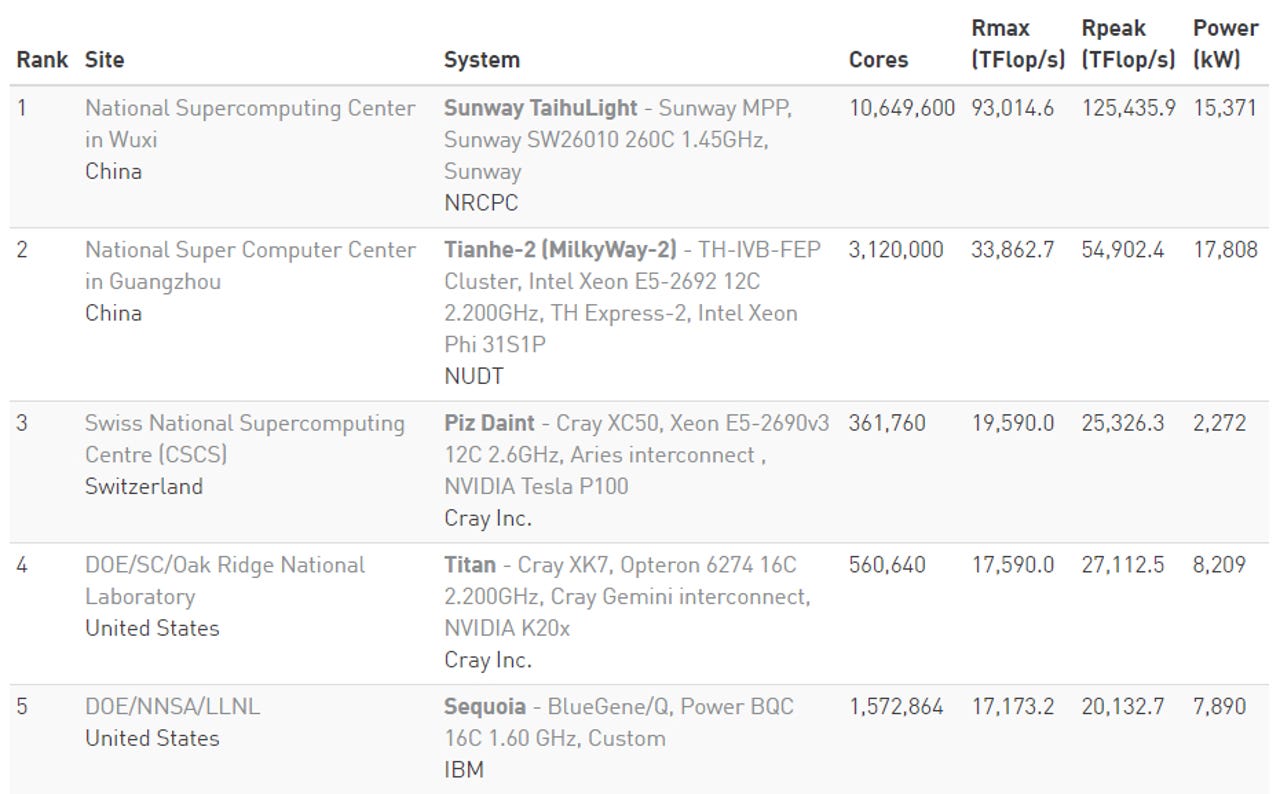Supercomputing Top500: US knocked out of 'top three most powerful' list


The US still occupies two slots in the Top500 top five but both supercomputers fall outside the top three.
A Cray system in Switzerland is now the world's third most powerful supercomputer, behind two Chinese systems.
That means for the first time in 21 years a US high-performance computing system is not one of the world's top three supercomputers, according to the June 2017 rankings by the supercomputer benchmarking project Top500.
The only other time a US supercomputer had failed to make Top500's top three ranking was in 1996, when the US was edged out by three Japanese supercomputers.
The pack is currently led by China's Sunway TaihuLight, by far the fastest computer on earth measured by floating-point operations, or flops. It was developed by China's National Research Center of Parallel Computer Engineering & Technology, NRCPC, and is capable of 93 petaflops, or 93 quadrillion flops, under Linpack performance tests.
That benchmark has remained unchanged since it launched in June 2016, notably with a Chinese-designed processor.
The second most powerful supercomputer is the Tianhe-2, or Milky Way-2, from China's National University of Defense Technology, which is capable of 33.9 petaflops.
A recent Nvidia GPU upgrade to Piz Daint, a Cray XC50 system, enabled the Swiss National Supercomputing Centre's system snatch third place from the Department of Energy's (DOE) Oak Ridge National Laboratory's Cray XK7 supercomputer, Titan.
Top500 notes that Titan's Linpack score has remained at 17.6 petaflops since it was installed in 2012. The Piz Daint's November score of 9.8 petaflops doubled after the upgrade with Nvidia Tesla P100 GPUs.
The slip by the US in the rankings follows a December report based on meetings between the DOE and National Security Agency that warned US leadership in high-performance computing was under immediate threat unless the US committed to a decade-long "surge" in investments to compete with China's accelerating development in high-performance computing, or HPC.
Without the surge, "the US can expect an HPC capability gap to emerge and widen in less than a decade", it warned. This gap would impact US abilities to build weapons and national security systems and have knock-on effects for HPC-dependent industries, such as automotive, aerospace, and pharmaceutical research.
The report noted that China viewed native HPC capabilities as a strategic goal for its nation-building objectives. While China's previous supercomputers were "unimpressive except for running benchmarks", the TaihuLight light was "not a stunt", the report's authors said. It was notable for being the first system entirely controlled by China in terms of hardware and software.
Today though, the US still leads China on a number of counts. US supercomputers made up five of the world's top 10 systems in the Top500. Also, with 169 supercomputers in the Top500, the US leads, just ahead of China's 160 systems.
Other top supercomputing nations include Japan, which has 33 supercomputers, while Germany has 28, France has 17, and the UK has 17.
The vast majority of chips in the Top500 list are Intel's Xeon or Xeon Phi processors, which power 464 of the systems, with the remainder being IBM Power or AMD Opteron CPUs.
Nvidia GPUs are the most popular accelerators, present in 74 of the 91 systems that use that technology. HPE was the dominant system vendor, with 144 of its systems in the top 500, while Cray leads in the performance stakes, representing 21.4 percent of the list's total performance.
Japan's supercomputers dominate the Green500 list. While they're not the most powerful, they are the most energy efficient. The greenest supercomputer on earth is the Tokyo Institute of Technology's HPE ICE XA-based TSUBAME 3.0, which ranked 61 in the Top500 list.
Yahoo Japan's Exascaler kukai system is second, followed by Japan's National Institute of Advanced Industrial Science and Technology NEC system called AIST AI Cloud.
The Department of Energy's Oak Ridge National Laboratory's Cray XK7 supercomputer, Titan, has slipped to fourth place.
More on supercomputing
- US drops $258m on supercomputer development to chase down China
- Nvidia's supercomputer toolset: Opening up workings of the human heart in real time
- Fujitsu to provide Kyushu University with new supercomputer for AI
- How supercomputing power is helping with anti-pollution plans like city-wide car bans
- How just 30 machines beat a warehouse-sized supercomputer to set a new world record